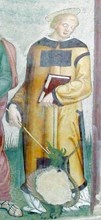


St Mamilianus (15th September)
St Senzius appears first among the saints who fled from Palermo with its bishop, St Mamilianus, when King Genseric of the Vandals sacked the city in 440. They took a boat and, after various stops, arrived at Montegiove, later Montecristo, off the west coast of Tuscany. There, St Mamilianus killed a dragon on the summit of a mountain. When St Mamilianus died, St Senzius and three companions buried him on the nearby Isola del Giglio.
St Senzius (25th May)
There are four surviving versions of the legend of St Senzius: BHL 7581, 7582, 7582b and 7582d. According to BHL 7582b, which is in the Leggendari del Duomo, St Senzius was guided by an angel to Spoleto after the burial of St Mamilianus. He lived on a nearby mountain (usually identified as Colle Ciciano) and became a shoe maker. He killed a dragon on the summit. Performing as a priest, he established a baptistery on the spot and baptised people in the name of the Trinity. (The juxtaposition of the killing of a dragon and baptism in the name of the Trinity suggests that the dragon represented the scourge of Arianism).
According to what seems to be a slightly later addition to the legend, when St Senzius died (apparently of natural causes, although he is often referred to as a martyr), the people of Spoleto erected a basilica over his grave and celebrated his feast there each year. A note that prefaces the legend in the Leggendari del Duomo says that he was buried next to St Mamilianus.
BHL 7582d, these events are set at Blera, south of Viterbo.
Two monuments in Spoleto are associated with this legend:
-
✴The baptistery that St Senzius built on the top of the mountain after he had killed the dragon is traditionally said to be the ex-church of San Michele Arcangelo. An inscription (17th century), which might have reproduced a much older one, recorded that a baptismal font here was moved to the Duomo after 428 (the year of the consuls Flavius Constantius Felix and Flavius Taurus). [Where is the inscription ?]
-
✴The basilica that was built over the tomb of St Senzius seems to have been San Salvatore. This church was first documented in 1064 as the "monasterium sancti concordi" (see St Concordius), but was known as SS Concordio e Senzia in the 12th century. The presumed relics of SS Concordius and Senzius are preserved in an urn (1727) with an identifying inscription that could reproduce an older one. [Where is the reliquary ??]
Read more:
The topos of the killing of a dragon, which is shared with the legend of SS Felix and Maurus (among others) is discussed in:
E. Susi, “La ‘Vita Beati Mauri Syri Abbatis et Felicis eius Filii apud Vallem Narci Prope Naris Ripam’ del Codice Alessandrino 89”, Hagiographica, 2 (1995) 93-136
Return to Saints and Venerated Objects of Spoleto.

